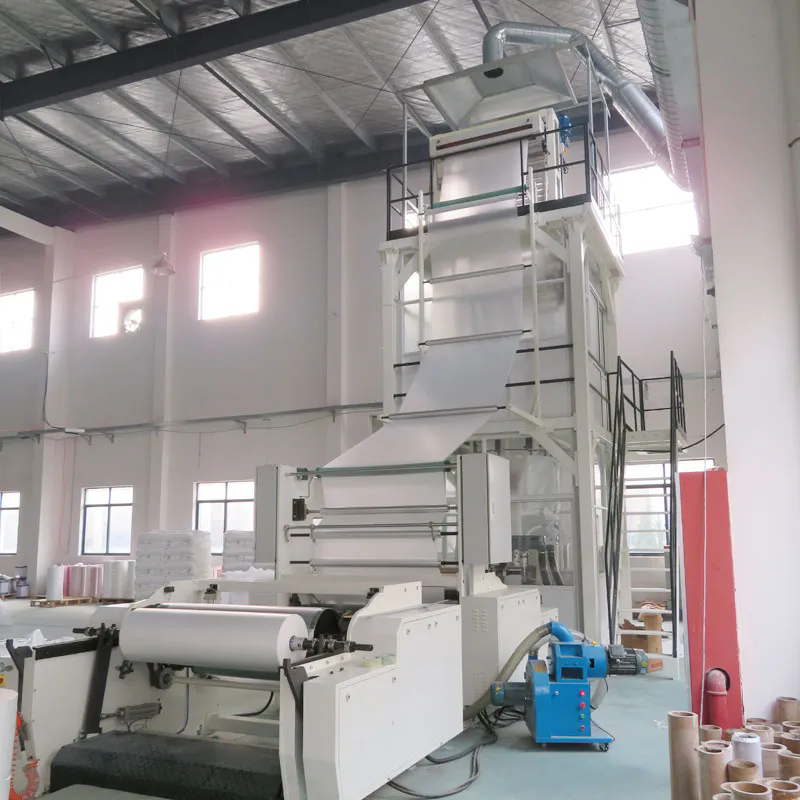Why Is the Blown Film Machine a Game Changer in the Packaging Industry?
2024-11-08
In the fast-evolving world of packaging, the blown film machine has emerged as a key technology revolutionizing the production of plastic films. Whether you're wrapping food products, creating flexible packaging for industrial goods, or making custom plastic bags, blown film machines are essential in meeting the growing demand for high-quality, cost-effective packaging solutions. But what exactly makes this machine so impactful, and why is it becoming indispensable in modern manufacturing? Let's take a closer look at the benefits and applications of blown film technology.
What is a Blown Film Machine?
A blown film machine is a piece of equipment used in the production of plastic films. The process involves melting plastic pellets (usually polyethylene, polypropylene, or other materials) and extruding them into a thin film. The film is then inflated into a tube-like structure, which is expanded further by air pressure before being cooled and rolled up for use. This process results in a flexible, durable plastic film that can be used for a wide range of applications, from packaging to construction.
The versatility of blown film machines allows manufacturers to produce films of varying thickness, texture, and strength, making it a highly adaptable technology for a variety of industries.
Why is the Blown Film Machine Essential?
1. Versatility in Applications
The blown film process is incredibly versatile, making it suitable for numerous applications across different industries. Blown film machines can create films for:
- Packaging: Used for food packaging, plastic bags, and retail packaging.
- Agriculture: Creating films for greenhouse coverings, mulch films, and more.
- Industrial Uses: For products such as protective covers and insulation materials.
- Medical: Used to produce sterile wraps, pouches, and medical device packaging.
This versatility makes it an essential tool in various sectors, offering different options for thickness, barrier properties, and film strength.
2. Cost-Effective Production
Blown film machines allow for high-volume production, which translates into cost savings for manufacturers. The automated process ensures minimal labor costs while maximizing output. The efficiency of these machines in handling various plastic materials also helps reduce material wastage, leading to more sustainable and affordable production. Manufacturers can produce large quantities of high-quality films without the need for expensive manual processes.
Additionally, since the production process is continuous, it also eliminates the need for costly secondary operations, such as cutting and shaping, making it a highly efficient and cost-effective manufacturing solution.
3. Customization for Specific Needs
Blown film machines offer excellent flexibility when it comes to customizing the properties of the film. By adjusting the parameters such as extrusion speed, air pressure, and cooling rate, manufacturers can fine-tune the characteristics of the plastic film, including:
- Thickness: Films can range from very thin (used for packaging) to thicker, more robust films (used for industrial applications).
- Strength: Films can be made with varying degrees of strength depending on the application—whether it’s for light-duty packaging or heavy-duty industrial use.
- Barrier Properties: Special films can be made with enhanced barrier properties for moisture, UV light, or oxygen, which are ideal for food packaging and medical products.
This adaptability makes blown film machines an excellent choice for a wide variety of markets with specialized needs.
4. Environmental Impact and Sustainability
The packaging industry has increasingly faced pressure to reduce its environmental footprint, and blown film machines can help meet this demand. While plastic packaging is often viewed as problematic for the environment, blown film technology allows for the use of recycled materials and biodegradable films. Manufacturers can use post-consumer recycled plastics (PCR) to create new films, minimizing waste and reducing reliance on virgin materials.
Moreover, the process itself is efficient, which means less energy is required to produce the same amount of film compared to other methods, further reducing its environmental impact.
5. High-Quality Output
Blown film machines are known for producing films with consistent quality and clarity. The controlled environment during production ensures that the finished films are free from defects, offering superior quality compared to other methods of film production. The smooth, uniform texture of the film produced by blown film machines makes it ideal for printing and labeling, giving manufacturers the ability to brand their products effectively.
6. Innovative Film Types
Blown film machines can be used to create different types of films, including multilayer films, which offer superior strength and barrier properties. These films are ideal for more demanding applications such as packaging products that require extra protection, like pharmaceuticals or fragile electronics. The ability to create multi-layer films also opens the door to films that incorporate special features like anti-static properties, UV resistance, and oxygen or moisture barriers, increasing their value in specialized industries.
How Does the Blown Film Process Work?
The blown film process begins with the extrusion of plastic pellets through a die to form a tube-like structure. The tube is inflated with air, which causes the film to expand. This is why it’s called the "blown" film process—because air pressure is used to form the film. The expanded film is then cooled, usually by air or water, to set its shape and properties. The finished product is then wound onto rolls, ready for further processing or use in packaging.
Conclusion
Blown film machines are vital to the modern packaging industry, offering efficiency, versatility, and cost-effectiveness. Whether you're creating a plastic bag, food packaging, or specialized industrial films, this technology provides the flexibility to meet diverse needs across multiple sectors. From the ability to adjust film thickness and strength to creating innovative, eco-friendly packaging solutions, blown film machines continue to drive innovation and improvement in the world of manufacturing and packaging.
So, if you are in the packaging business or looking to optimize your manufacturing process, investing in a blown film machine might just be the game changer you're looking for.



